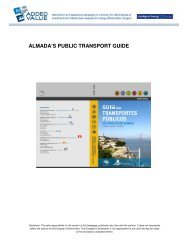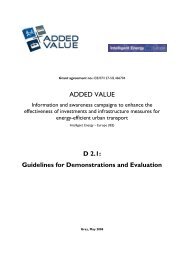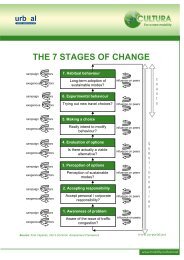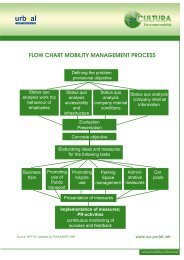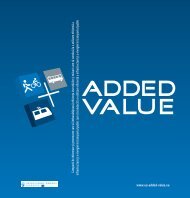SUMO - Eltis
SUMO - Eltis
SUMO - Eltis
You also want an ePaper? Increase the reach of your titles
YUMPU automatically turns print PDFs into web optimized ePapers that Google loves.
4. Describing the task and setting overall goals<br />
4.1 PROJECT DESCRIPTION AND OVERALL GOALS<br />
In order to monitor and evaluate projects, it must be defined what a project is to<br />
achieve. It is important to formulate a project description. This should include a<br />
realistic and measurable target in addition to the overall purpose.<br />
An example of a project description and overall<br />
goal for the Test Traveller project:<br />
The project aims to persuade habitual motorists to change their habits and travel by bus to work<br />
in order to reduce environmental impact and congestion in the urban centre.<br />
For county transport companies, the overall aim of the project is to increase opportunities to<br />
entice more people to travel by bus. It is interested in opinions from unaccustomed bus commuters<br />
to help improve commuter relations and to provide greater opportunities to increase the number<br />
of bus commuters in the longer-term.<br />
The aim for the local authority is to reduce environmental impact and congestion.<br />
Describe the task and draw up a schedule for when the different targets should be achieved<br />
and when measures (that should help to achieve them ) are to be implemented.<br />
The effects on behaviour resulting from the evaluated project should be discernable<br />
from other changes. It is therefore important to describe the background, i.e. the external<br />
factors (level Y) and the person-related factors (level P). In a comparison of pre and<br />
post data both external factors and person-related factors must be known to obtain fair<br />
results.<br />
EXTERNAL FACTORS (LEVEL Y)<br />
External factors are local conditions that are equal for all users. Examples of external factors<br />
include the location of a business, access to public transport, access to cycle paths,<br />
parking fees, legislation, and type of transport.<br />
Knowledge can be found in secondary data, interviews with well-informed persons at<br />
the local authority, businesses and the preliminary assessment carried out as part of the<br />
project.<br />
sumo – System for Evaluation of Mobility Projects<br />
PROJECT DESCRIPTION AND OVERALL GOALS<br />
17



